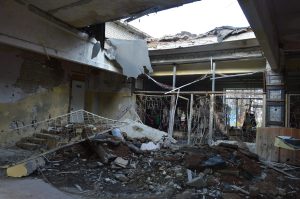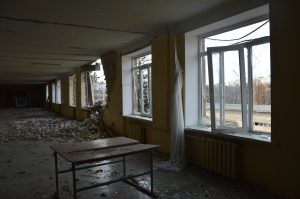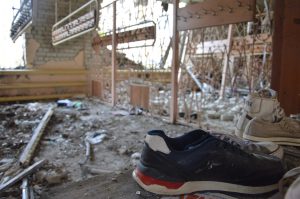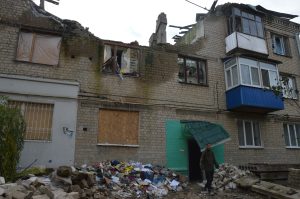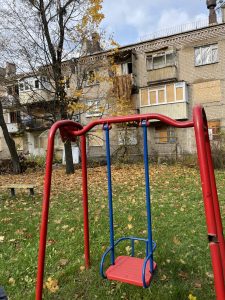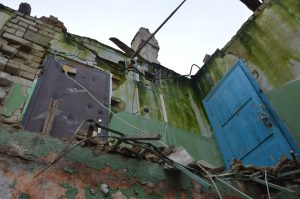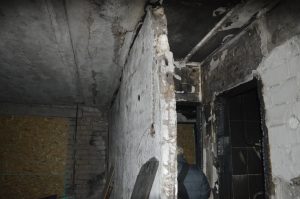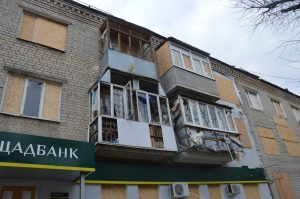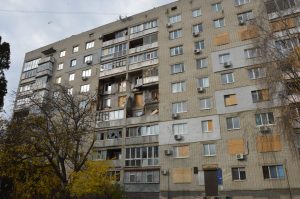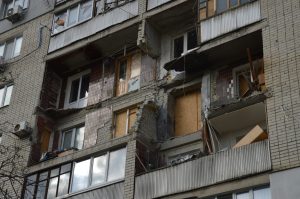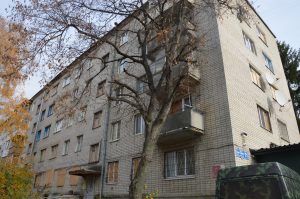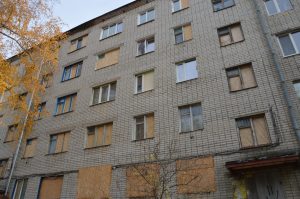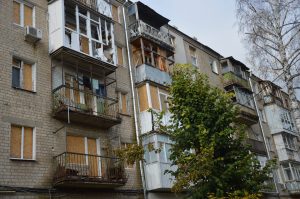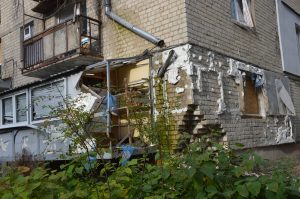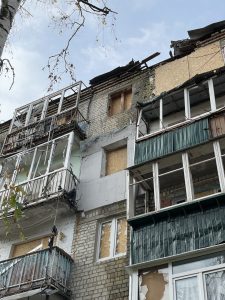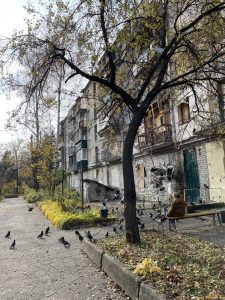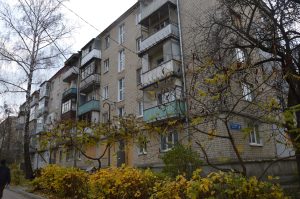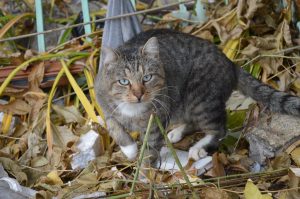Piatykhatky is a neighborhood of Kharkiv, Ukraine, formerly a small village.
Piatykhatky (“Five huts” in Ukrainian) is a neighborhood of Kharkiv, Ukraine, formerly a small village. After construction of new premises of the Ukrainian Physics and Technology Institute (now National Science Center Kharkiv Institute of Physics and Technology) there in the 1950s Piatyhatky became incorporated into the Kharkiv city. The state border with Russia is 25 kilometers north of this district. [Source: Wikipedia]
You can find all the places mentioned in this story (and more) in this map:
February 24, 2022
[Natasha Tagayeva, volunteer]: The border is 25 kilometers from us. And it all hit us right away on February 24. Because, in fact, we were the first to hear it. Shots, and then Russians started to hit us, and the transport stopped moving. And people lost the opportunity to earn or buy anything. There was a moment when our transportation did not function. All shops were closed, totally.
Paramedic’s story
[Victoria Kravchenko, paramedic]: In the early days of the war, there was chaos like everywhere else. It was very hard under fire. I had to cover the entire village, go for the wound dressings.
And then there was a blackout in the village. There was no light, there was no water, there was no mobile communication, and we ended up in a complete vacuum.
The end of March and the month of April the ambulance did not even want to come here. It was very difficult to work in this sense due to the lack of communications, water and gas.
Animal rescuer’s story
[Valentyna Pirozhenko, animal rescuer]: When the war started, most people were evacuating, and often they did not know where they were going, how far they were going, and did not know where they could settle down. Therefore, a lot of people just left their animals here and went away. And at some point it turned out that we have practically no people, and a huge number of cats and dogs, more cats. Every week we had about 300, 400, 500 cats. And we fed them. We have people who stayed here and didn’t go away, who are taking care of similar flocks of cats.
Chef’s story
[Vladislav Frolov, chef]: I started making bread because all the shops were closed. I started baking bread at home. There was no light or water for 45 days. We cooked on gas stoves.
For me probably the biggest problem was the lack of gas, when we were out of it, and the lack of products. Then it was easier to collect water, we were melting snow. Products were brought to us by a bag, by a pack, kilogram by kilogram.
Once a 90-year-old grandmother came and said: “Guys, I have neither water nor gas, I want to eat.”
We then prepared some kind of rice or pasta soup.
Spring 2022
[Adam Sybera, analyst]: The roof of one of the housing complexes in Piatykhatky was hit by a rocket artillery grenade, and this caused significant damage. The impact virtually destroyed the entire elevator.
[Adam Sybera, analyst; Natasha Tagayeva, volunteer]: There was another impact site of artillery shelling. During the time of the hit, there was a line of people here waiting for humanitarian aid. Eight people, unfortunately, were killed.
[Andriy Tagayev and Natasha Tagayeva, volunteers]: The school was also bombed. There was massive shelling here, very heavy damage to the building, extensive destruction on the third floors of the school. Ironically, the class was taught in Russian. It was just this very class that was hit, from the whole school. There, even the roof above it has caved in, there are practically no unbroken windows left in the school, the roof is all broken.
[Nataliya Zubar, MMIC]: Thе medical clinic that has been destroyed by apparent intentional targeting. The expression “wear shoe covers” is especially apropos here… I’m not going to go further, everything is quite wrecked here. This WAS a medical clinic.
Broken glass is now a completely normal sight in Kharkiv. Well, not normal, of course, but commonplace. Of course, whatever you see here is not normal.
Damage to the Physics and Technology Institute
[Nataliya Zubar, MMIC]: Institute of High Technologies (previously it was named Physical-Technical Institute), part of Kharkiv National Karazin university. It has been shelled many times by Russian weaponry. In the early spring there was a strong wind, and whatever was not broken by shelling was being broken by natural reasons. Probably all the stuff, all the equipment, unique equipment was destroyed inside. I can not possibly see how it could survive such a fire.
There is a Russian vehicle that carried the munition which could actually be fired to Kharkiv, but luckily it wasn’t.
It is very symbolic that this place has an unbroken memorial plate to the head of the civil headquarters of the Kharkiv protection, Ihor Tolmachov, who is an alumnus of this institute, who died during the terrorist act of Russia on February 22, 2015.
A tour of a kind…
School #62, Academician Kurchatov Avenue 23
1,121 children studied here before February 24. The most destroyed class in the school is the one where a whole series of subjects were taught in Russian at the request of the parents. And the only room that was not damaged by shelling is the school museum of Ukrainian ethnography.
The building of the primary school became a shelter for the residents of Piatykhatky. At the beginning of the full-scale invasion, more than a hundred people were hiding here.
A ninth-grader from this school was killed in May. Together with his parents, he evacuated the bison from the ecopark and came under fire.
Residential building, Yevpatoriisky Passage 2
Apartments on the second floor of a two-story building were completely destroyed by Russian missiles. Living in this building is completely impossible due to the threat of collapse.
Russian books and various symbols of the Soviet Union were found on the spot, so the “Russkiy mir” came here as it really is.
Residential building, Academician Kurchatov Avenue 12
The owner of the affected apartment on the 6th floor was not at home, the neighbor was also lucky enough to spend the night at a friend’s house. From the explosive wave in the neighbor’s apartment, everything fell on the bed. If the neighbor had slept in his own bed, he would have been crushed by things that were thrown away by the impact.
Residential building, Academician Volkov Street 1
At the beginning of the war, the walls in the apartments on the 2nd and 3rd floors, as well as the windows, were completely knocked out with Multiple Launch Rocket Systems (MLRS). So far, it has been possible to close the broken wall from rain and cold, but the ceiling in the building is in a state of emergency and may endanger the remaining residents.
Residential building, Academician Valter Street 7
The building was shelled at the beginning of March. The hits were from the village of Tsyrkuny, which were then controlled by the Russian troops. A shop next door was also damaged during this shelling, which at the time remained the last working shop in the area. According to locals, up to 5 people were injured in the shelling, two of whom died.
Residential building, Academician Valter Street 21
From the outside, it may seem that the building is intact, there are just no windows. But in reality, it has large holes in the roof and destroyed apartments on the upper floors. In this building, the inhabitants will not be able to spend the winter due to broken heating pipes. During the summer and the autumn, water flowed and flooded the apartments, which did not have time to dry.
Residential building, Academician Valter Street 12
The floors in the apartments are destroyed by the explosion, and even a light blast wave can cause the section to completely collapse. Several people live in this section, exposing themselves to danger.
Residential building, Academician Valter Street 10
Destroyed apartments on the first floors, a house damaged by debris and a lonely elderly woman, one of the few on the entire street. There is almost nothing to do in the city, especially for the elderly, but most of those who remain simply have nowhere to go.
Residential building, Peace Boulevard 4
We met here a girl who went out to feed the cats, but took the wrong keys and could not get into the section. She says that there is no one but her in this section, so she called the local, who is covering the windows with oriented strand boards in Piatykhatky, to let her in. She is a local activist, something like that.
Autumn 2022
[Adam Sybera, analyst]: Life is slowly returning to normal I’d say. The repairs are in process. And we can see that people are also returning. The destroyed elevator is now functioning again. However, it’s still provisional repairs.
Covering windows
[Serhiy Bajrachnyj, volunteer who covers broken windows with oriented strand boards]: We are cutting the sticks for insulation for plastic windows. This is when the entire metal-plastic frame is disassembled, the double-glazed window is removed, and chipboard is inserted into the double-glazed window, and further compacted and hammered with sticks. Everything turns out harmoniously, only it is dark in the house. And there is no access to fresh air, and more or less warm.
Now winter is coming. Snow will not get there, rain will not get there. At the moment, this is how we cope. We close the windows in the damaged houses, where the windows have blown out.
[Adam Sybera, analyst]: Unfortunately, schools are an often target of Russian artillery and Russian aggression. This is going to be a big problem after the conflict is over. Because the kids that are right now studying online will need to come back to school at some point. And so many schools have been destroyed, that there will be problems with either just capacities, and generally lack of educational institutions because of the destruction.
Health situation
[Victoria Kravchenko, paramedic]: The number of sick people is not getting smaller. A lot of old people came back, who require treatment for chronic diseases. Lots of infected wounds to treat. Here’s what you have to work with.
We are in kindergarten. The medical office was completely unsuitable. Everything we have here, and the tools with which I work, and medicines, all had to be obtained a hard way. A normal examination couch for an adult was brought by a volunteer from Scotland. This is how help was collected all over the world.
Now there is no heating. We warm ourselves up with a fan. I work with patients with cold hands. They have to undress. In general, the room should be heated.
Animals
[Valentyna Pirozhenko, animal rescuer]: Animal food is a huge problem. Because, since the humanitarian situation in the country is difficult, and people need to be helped. Animal food is almost impossible to get. Unfortunately, we do not have any funding. There are many animals, but little food. And how to deal with it? I can’t even imagine.
[Natasha Tagayeva, volunteer]: All of this arose spontaneously. Am I a “volunteer”, or not “volunteer”… No one cares about titles. The main objective is to help people.
The full versions of interviews with people of Piatykhatky are in this playlist (all non-English videos have English subtitles):
References
All the photos and videos of this project are made by Yuliia Gush, Yevgen Tytarenko, Oleksii Svid, Kateryna Yashysh, Petr Pojman, Adam Sybera, and Nataliya Zubar.
Compiled by Vira Gryaznova.
Edited by Nataliya Zubar.
This project has been funded by Crown Agents International Development.




